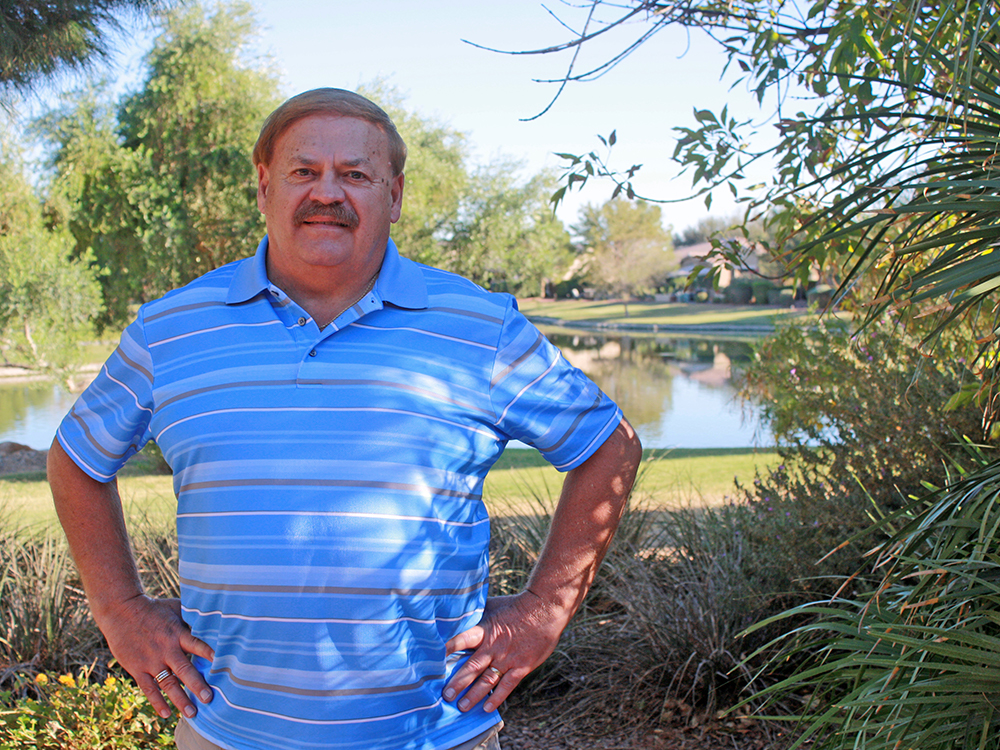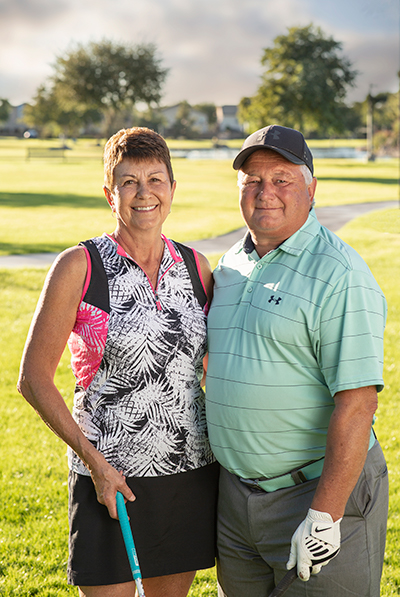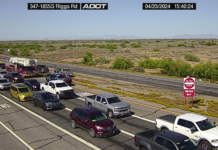
Snowbirds Jeff Zerr and Dave DeVos are back.
Tony Zarrillo is not.
“The risk is too great,” he said.
The pandemic’s impact on Maricopa’s winter visitors is still playing out, but some fallout is already evident.
The U.S.-Canadian border, closed to non-essential travel in mid-March, looks to remain sealed well into 2021, with recent waves of coronavirus cases hitting both countries, according to reports. Airlines are flying, however.
“I know there’s a lot of people worried about what’s happening south of the border in Florida, Arizona, California and other places where the virus is not under control or less under control than we are here,” Prime Minister Justin Trudeau told USA Today in mid-October. Since then, the number of positive cases has climbed dramatically in the United States and Canada.
“Until the virus is significantly more under control everywhere around the world, we’re not going to be releasing the restrictions at the border,” Trudeau told the Canadian Broadcasting Corp. in early December.
Maricopa snowbirds are conducting their own assessments of the health risk posed here by COVID-19.
Some are making the trip — Zerr and his wife arrived in early November, a couple weeks earlier than usual — while others are staying put in cities and towns around the United States and Canada.
Others, like Zarrillo, have surrendered the snowbird lifestyle they enjoyed so much here.
Amid all the uncertainty, one thing is for sure: the public health crisis will mean fewer snowbirds in Maricopa this winter. Some will come anyway, but others are unable to make the trip or choosing to stay away. Some are selling their homes or have already sold.
‘THIS YEAR WILL BE DIFFERENT’
Zerr, 62, lives in Weyburn, Saskatchewan, a town of 10,000 in the southeast part of the province, about 46 miles north of the North Dakota border and about 1,220 miles away from Maricopa.
He and his wife, Judy, bought a house in Maricopa Meadows in 2011 and their annual winter treks have gone like clockwork — until the pandemic. They have two grown sons and two granddaughters.
“It’s been a very good experience,” he said. “We do love coming down to Maricopa.”
Zerr said they carefully evaluated the state of coronavirus here before deciding to make the trip. But the virus, he was quick to add, is most definitely altering the plans of some of his fellow Canadian snowbirds.
“Some are coming down later,” he said. “Some are not coming down at all.”
DeVos, a Minnesota resident who retired from a career in agricultural finance, said he has heard the same thing from fellow members of the snowbird club at Province. Some, especially Canadians who are dealing with the border closure and health insurance concerns, have told DeVos they are even thinking of selling.
“As far as the Lower 48, I haven’t talked to any who are not planning to come down,” he said, noting the virus is changing traditional plans for some.
DeVos, 67, who got to know Maricopa through his work with local dairies, had a home built in Province in 2011. He is past president and current vice president of the social organization at the 55+ community, which numbers as high as 500 members.
The pandemic is not changing his plan, however. He made it to Maricopa in early November. He will head back to Minnesota for the holidays and return for the rest of the winter.
Zerr said an Alberta snowbird who lives across from him in the Meadows is putting off his southern trip until after Christmas.
“I figure this year will be different,” Zerr said. “It’s a different world.”
The Zerrs are already playing golf at The Duke at Rancho El Dorado, one of their favorite social activities. But they expect health concerns will alter some of their usual activities. They will likely forgo trips to the casino for a show to avoid big crowds.
The retired telecommunications technician said protecting oneself is all about common sense. He and his wife have no qualms about wearing face masks, physically distancing and steering clear of large gatherings.
Maricopa, indeed much of America, is different from his neck of the woods in Canada, he said.
“It’s more densely populated in the States,” he said. “But our (social) bubble is pretty small. It’s something that will have to run its course.”
DeVos, who doesn’t see any additional health risk in Arizona compared to Minnesota, where a face mask mandate remains in place, agreed snowbirds who make the annual migration will likely alter their traditional social lives to stay a bit closer to home in Maricopa. Because of the uncertainty, the Province club has yet to plan activities, including a casino night.

‘WE MISS OUT ON SOMETHING WHEN SNOWBIRDS DON’T COME’
The term “snowbird” was first used in the 1920s to describe seasonal workers who headed south for the winter months. By the late 1970s it was being used to describe the many retirees flocking to sunny and warm locations for the winter. A negative connotation — slow drivers, early-bird diners — persists for some more youthful people.
“I’ve been in Arizona almost my entire life,” said Mayor Christian Price, harkening back to his younger days. “We would make fun of snowbirds in a locals versus winter visitors type of thing.”
Now, as the top elected official in Maricopa responsible to a large degree for the city’s fiscal health, Price learned long ago not to take the retirees for granted.
“Our economy completely depends on them,” he said. “A lot of homes here are owned by folks who live in Canada and elsewhere. They spend (money) here.”
Their economic contributions to Arizona municipalities and businesses are staggering. Canadian snowbirds alone contribute $1.5 billion annually to the state economy in the four to six months they are here, according to Glenn Williamson, founder and CEO of the Canada Arizona Business Council, which works to promote and increase foreign direct investment, trade and tourism between state and country.
They pay real estate taxes and sales taxes. They buy groceries and gas. They pay green fees at golf courses. They dine in local restaurants, order takeout pizza and have their nails done. Some have seasonal jobs.
Pat Kieny, owner of Native Grill and Wings, said sales at his restaurant typically grow 10% to 20% during snowbird season.
About 100,000 homes in Arizona are owned or rented by Canadians, who spend $13 billion on real estate annually.
They own thousands of local homes, according to Williamson. “In a town like Maricopa,” he said in September, “the Canadians and Americans who live there as neighbors co-exist as one. It’s like family.”
“Snowbirds have been taken for granted for decades,” he added. “And then COVID-19 comes along … we are going to start noticing.”
For months, Williamson has been trying to figure out how to enable Canadian snowbirds to drive down to their second homes in Arizona.
Part of the heightened concern results from an assumption by Williamson there will be “no completely open border until we get a vaccine. The money that is lost every day in tourism is mind-numbing.”
Long-term, the winter visitors look to enrich state and local economies for years to come.
“Today’s snowbirds aren’t your retired grandparents’ snowbirds,” Williamson said.
The demographic profile is changing, he explained, with more snowbirds who are younger business executives who first experienced Arizona as a tourist and now spend winters here. They take full advantage of technology to run their Canadian companies from the greater Phoenix region, which averages 300 days of warm sunshine a year.
“They can work wherever they want,” he said. “Maricopa is very much part of that.”
Williamson had high praise for Price, calling him a leader who pays attention to snowbirds and their impact on the bottom line.
But Price was quick to add snowbirds’ contributions to the community go beyond their wallets.
“They bring knowledge, they volunteer at our schools, they bring diversity,” he said. “We miss out on something when snowbirds don’t come.”
‘IT WAS A GOOD TIME TO SELL’
In mid-March, many snowbirds went home early from their winter homes as the first wave of the virus spread around the world. Some had to do it in a rush.
Zarrillo, 63, a Winnipeg resident, was a Maricopa snowbird until this year.
In 2009, after the real estate market crashed, he and his brother-in-law came down to the city and liked what they saw. The trip, the men had agreed with their wives, was a fact-finding mission only. By the time they left, however, they had co-signed on the purchase of a cul-de-sac home in Glennwilde.
“We were really impressed with the growth and layout,” said Zarrillo of the development. “It was very safe, quiet.”

Until 2016, the four friends and owners worked full-time. The Zarrillos would visit the home on West Lucera Court for two weeks in November and then again in February or March.
For the last four years or so, Zarrillo and his wife would spend winters in the warmth, hosting their children and grandchildren. A retired manager of an automotive testing equipment company, he played lots of golf. He socialized with the other residents on the cul-de-sac, many of them from different parts of the Great White North.
“It was a nice little clique going on there,” he said.
In February, coronavirus changed everything. In mid-March, the Zarrillos received a bulletin from their health care provider telling them their coverage would be canceled at the end of March if they didn’t return to their home country.
Within the week, they were packed and on the road for the 37.5-hour drive to Manitoba.
They have not been back.
Health insurance is a particular obstacle for Canadian snowbirds right now, according to Williamson. Universal health coverage only covers citizens traveling abroad for three days. As a result, the retirees’ provincial or territorial health plan may cover none, or only a small portion, of costs for medical care in the United States. Typically, travel health insurance is purchased to ensure adequate coverage.
But with the current public health crisis deemed a Level 3 pandemic, travel health insurers are not covering COVID-19-related medical expenses, including quarantine costs.
With the reopening of the U.S.-Canadian border delayed month-after-month and the virus persisting, Zarrillo said the two couples sat down to mull the future of their home. Overhead was the same whether it was used or not, and the Canadian dollar was weaker, they reasoned.
But the uncertainty of COVID-19 — “we don’t know when it is going away,” Zarrillo lamented — tilted the argument.
“The U.S. is the epicenter of the epidemic,” he noted. “More cases than anywhere in the world.”
They decided to sell, taking some solace in buying near the bottom of the market 11 years ago and taking advantage of today’s sizzling sellers’ market. They sold in August. They weren’t alone.
“There’s just two (remaining members of their Canadian clique) on the cul-de-sac now,” he said in mid-October from Winnipeg, where a dusting of snow had fallen the night before.
“It was a good time to sell,” he added. “We were very fortunate.”
Brian Petersheim, a Realtor in Maricopa, said he has seen evidence of many snowbirds selling homes in recent months, with many properties selling furnished, or with furnishings being sold under a separate bill of sale.
The Zarrillos were in the same situation. Unable to return to collect their belongings, they threw open the doors of their home and invited neighbors to take what they wanted. They also gave away a vehicle.
Sadly, Zarrillo said he’ll probably never enjoy the snowbird lifestyle again.
“I don’t think we’ll ever see the opportunity again,” he said. “It was enjoyable. We love the state. Great people. And the community was very good. We’re going to miss it.”
But that doesn’t mean he won’t be back.
“Once this pandemic is over, we’ll definitely be returning for a visit.”
FALLOUT FROM COVID-19
We asked several businesses in town if they are seeing fewer snowbirds this year due to the pandemic. Here is what their representatives told us:

“I am seeing fallout, unfortunately. None of our Canadian visitors are back. That’s a huge chunk of our clientele. A few of our winter visitors have come back, but less than half.”
Kristina Donnay
Maricopa Wellness Center
“We have patients who usually come back in October, but we haven’t heard from them. We haven’t had a lot of them come back this year.”
Sandy Creamer
Maricopa Foot & Ankle Center
“We’re getting a lot of North and South Dakotans back, and Wisconsin. But fewer Canadians. I’ve only seen 4-5 Canadians come back (instead of the 100 or so in a typical year.) The Canadians aren’t here with their horses.”
Connie Majors
Ace Hardware

![MHS G.O.A.T. a ‘rookie sleeper’ in NFL draft Arizona Wildcats wide receiver Jacob Cowing speaks to the press after a practice Aug. 11, 2023. [Bryan Mordt]](https://www.inmaricopa.com/wp-content/uploads/2024/04/cowing-overlay-3-218x150.png)




![Maricopa’s ‘TikTok Rizz Party,’ explained One of several flyers for a "TikTok rizz party" is taped to a door in the Maricopa Business Center along Honeycutt Road on April 23, 2024. [Monica D. Spencer]](https://www.inmaricopa.com/wp-content/uploads/2024/04/spencer-042324-tiktok-rizz-party-flyer-web-218x150.jpg)





![Alleged car thief released without charges Phoenix police stop a stolen vehicle on April 20, 2024. [Facebook]](https://www.inmaricopa.com/wp-content/uploads/2024/04/IMG_5040-218x150.jpg)

![MHS G.O.A.T. a ‘rookie sleeper’ in NFL draft Arizona Wildcats wide receiver Jacob Cowing speaks to the press after a practice Aug. 11, 2023. [Bryan Mordt]](https://www.inmaricopa.com/wp-content/uploads/2024/04/cowing-overlay-3-100x70.png)


